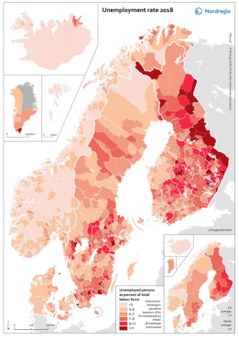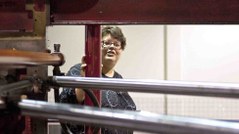Labour Market
Finland: Unemployed youths get more attention
Finland’s youth guarantee means young people have become a higher priority within the public sector.
The Nordics: Failing reforms exclude youths with disabilities
More flexibility does not lead to a more inclusive labour market. Political reforms carried out in the Nordic region in the first decade of the millennium do not have any measurable effects either, concludes the Nordic research group behind the report ‘New Policies to Promote Youth Inclusion’.
Anda Uldum: The man with the key to the national coffers and the mines
Greenland’s new Minister of Finance and Raw Materials, Anda Uldum, is facing a giant challenge.
The minimum wage — threat or opportunity?
Stop worrying and join the debate about a legally binding minimum wage across the EU. That’s the bombshell from Bente Sorgenfrey, the new President for the Council of Nordic Trade Unions, NFS. Is fear for the debate the real problem, or is a statutory minimum wage a real threat to the Nordic model? The Nordic Labour Journal kicks off the debate in this month’s theme.
Swedish Transport Union: minimum wage could stop social dumping
There is strong opposition to a statutory minimum wage in Sweden. But the parties in the transport trade have started talking about making collective agreements universally applicable. The reason: pay cuts and social dumping resulting from the freedom of movement.
Only far left wants minimum wage in Finland
Finland is one of the Nordic countries which has not had a public debate about a minimum wage. The Left Alliance (VF), which is the party furthest to the left in Finland, is the only political party which has called for a statutory minimum wage. In April’s general elections the party’s manifesto will also include a promised minimum hourly wage of €10 — around €1,600 a month.
Denmark: more refugees and immigrants into work
Far too few refugees and immigrants in Denmark are in work, and there is broad agreement something needs to be done about it. Yet there is little support for the Prime Minister’s proposal to get refugees and immigrants to clean up Denmark’s beaches and fix swings in kindergartens.
Technology and cooperation key for sustainable development in the Arctic
The Nordic region needs to speak with one voice and develop joint technology if the northernmost parts of Finland, Norway and Sweden want to achieve sustainable development in the Arctic, according to the report ‘Growth from the North’.
Minister for Strategic Development Kristina Persson: make the Arctic “green”
So far she has been the least visible minister in the Swedish government. That’s about to change as she is setting up a think tank in the government offices.
Why own when you can rent? The sharing economy and working life
Uber, Netflix and Airbnb are names associated with the sharing economy — a term which tries to describe the rapid changes in the way we consume goods and services. We rent rather than own, we swap, share, borrow or give away. New technology allows for new kinds of transactions, which in turn influences working life.
Hotels threatened by the sharing economy
New digital services which bring sellers and buyers together are making inroads in traditional areas of business. Most successful of them all is American Airbnb which helps people rent out their apartments. The hotel industry in Finland is fighting back.
The sharing economy is changing the services market
Mow the neighbours lawn? Quickly get hold of a skilled handyman? More and more digital marketplaces are emerging in order to facilitate the link between those who offer and those who need services. There are many different solutions, and two of the market’s players predict that things are only just starting.
“Make the Nordic region a growth centre for the sharing economy”
The Nordic region can become a centre for the sharing economy, which would benefit all of society. But politicians are asleep at the wheel, thinks Charlotte Fischer from the Danish Social Liberal Party. She sits on the Business Council for Sustainable Development, the Congestion Commission and is a member of the regional council of The Capital Region of Denmark.
Women could determine the Nordic model’s future
A high employment rate for women is crucial to the future of the Nordic model. This was the main message from the OECD’s Mark Pearson as the report ‘The Nordic Model – challenged but capable of reform’, was being discussed at the meeting of Nordic labour ministers.
Sweden’s government crisis means less money for working life
On Wednesday 3 December Sweden’s Prime Minister Stefan Löfven announced snap elections will be held on 22 March 2015. His centre-left minority government’s budget was voted down in parliament, which also means the promised increase in spending for the Public Employment Service and the Work Environment Authority will not materialise.
Ylva Johansson: Minister for Employment with a feminist agenda
Her ambitions are clear: youth unemployment is priority number one. Second on the list is to match jobseekers and jobs. She wants to improve working conditions in female-dominated workplaces and she will fight for more social rights within the EU.
Social Europe under pressure
There’s a conflict between the EU’s social ambitions and national autonomy, not least when it comes to the labour market, Sweden’s newly elected Minister for Employment Ylva Johansson told a seminar in Stockholm on 22 October.
Social scientists must guide us out of the crisis
"There is a fire of resentment burning across Europe, and there’s an urgent need to calm tensions. Social scientists need to get involved. Dogmatic economists have been allowed to dominate the debate for too long," says Maurizio Ferrera, Professor at the University of Milan.
A guarantee for the future?
There are fewer young people outside education, employment or training in Denmark than in Sweden. Why do the Danes succeed? While all of Europe is learning from the Finnish youth guarantee, the Nordic Labour Journal has spoken to Nordic youths about their experiences, and examined how countries succeed with their measures. Central to them all are vocational educations, apprenticeships and internships.
Fewer youths equals more jobs?
As the workforce ages and the number of young people of working age falls, their chance of finding a job increases. But it is still too early for politicians to sit back and relax. Powerful measures are needed to fight youth unemployment. One solution is to create more apprenticeships.
Document Actions



 Follow us on Facebook
Follow us on Facebook
